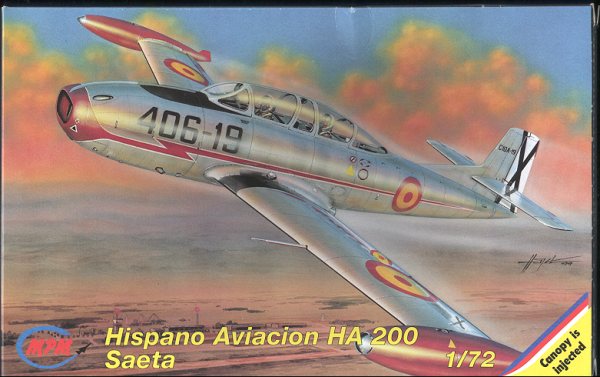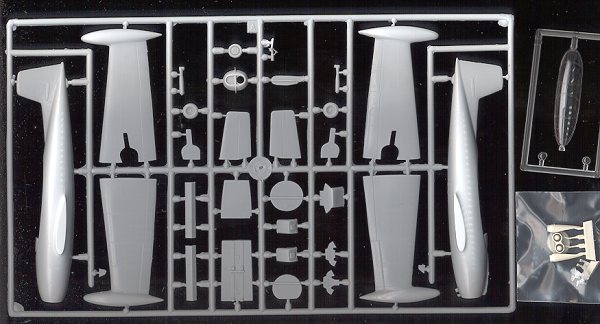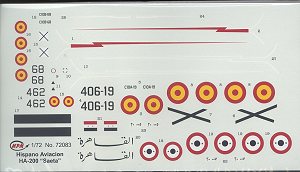
| KIT: | MPM 1/72 Ha.200 Saeta |
| KIT # | 72083 |
| PRICE: | $ |
| DECALS: | Two aircraft |
| REVIEW & | |
| NOTES: | `Short run with resin parts. |

| HISTORY |
Dateline: Spain - early 1950s. The Spanish A.F. wanted to produce a jet trainer that was to take their pilots into the jet age, and they wanted one that was made in Spain. Proposals were put forward and Hispano put forth a proposal for a twin-engined, jet trainer. It didn't hurt that Willy Messerschmitt was helping to design the aircraft! It was designed to replace the older Ha.100 and T-6 prop planes. A requirement for weapons so that it could be used for light attack was part of the program.
Well, things don't move as quickly in some parts of the world as the other. The first flight of the Ha.200 took place in mid 1955. The aircraft flew well and was armed with twin 7.7mm machine guns. It was found that some additional stability was needed so a small strake was added on the upper nose of the aircraft. Some ease of maintenance was considered in the design, but engine mechanics were not thrilled with the way it turned out. The engines were ahead of the cockpit section and while easy to get at, dropping a tool in the engine bay meant disaster. There was no lower removable engine panel to retrieve dropped items. This meant that in a worst case, the engine would have to be removed to retrieve the tool. Mechanics learned to tie tools to their wrists to prevent them falling!
By the time production was underway in the late 1950s, the T-33 was widely available for less than the cost of an Ha.200. However, Spain felt it was better to have a home manufactured aircraft so production continued at a modest pace. The only export of the aircraft was to Egypt, which had a number on hand during the 1967 war. By this time the nose machine guns had been replaced by 20mm cannon. All Hispanos were in aluminum with red nose and fuselage markings. By the early 1970s an easy to maintain ground attack aircraft was needed to fight Polisario guerillas in Spanish African territories so the Saeta was chosen. It was painted in the 'F-5' camouflage scheme and sent into action in 1974. It also saw some action in Morocco during that time. The by the early 1980s the aircraft was getting expensive to maintain and was officially retired in 1982. A large number of those planes were sold to warbird enthusiasts and has proven to be a quality aircraft. It is easy to maintain, easy to fly, and has a very strong airframe.
| THE KIT |

Probably the best thing that MPM has done over the last year or so is to get away from the vacuformed canopy. Most of us would much rather have an injected version as they are a lot easier to work with. MPM kits have also been improving a great deal and are slowly approaching what one expects from a main-line injected kit. This one still has some of the short-run trappings. It has resin parts, no alignment pins on parts, large ejector stubs on the bigger parts, and some flash on the rest of the pieces. The canopy is thinner than on previous kits though still brittle and not crystal clear.
The resin bits are for the intakes, exhausts, control sticks and the oleo scissors. No etched metal fret is included and I don't miss it at all! You do have to make a pitot tube from stretched sprue as well, but that is no big thing and dimensions are given. There is no wheel well detail and many of the parts are butt joined. Again, it isn't a problem for those of us used to these kits. When you get to the cockpit you'll notice that it has side consoles and instrument panels with engraved and raised detail. Nothing fancy, but it should look a lot better when painted and dry-brushed. The seats are simple and not very fancy. I'm not sure if the Saeta had ejection seats or not, but I'd guess not looking at the kit. A nice touch is that the wheels are one piece and you don't have to glue two small halves together. I appreciate that!
 Instructions have not changed. Four basic construction steps, a parts breakdown and three decal options. Colors are given only for exterior painting. I'd guess that black is the basic interior color. Markings are for a Spanish AF plane in overall natural metal with the red markings. This one from 406 squadron. The Saeta was not used by too many units. The other similarly painted plane is for the Egyptian AF in 1960. Finally an 'F-5' painted aircraft with smaller markings of 462 squadron in 1975. The sheet includes two different fuselage flashes. One with and one without the red interior. Most of us will choose the one with the red inside and try to match it! They are superbly printed as are almost all Czech decals.
Instructions have not changed. Four basic construction steps, a parts breakdown and three decal options. Colors are given only for exterior painting. I'd guess that black is the basic interior color. Markings are for a Spanish AF plane in overall natural metal with the red markings. This one from 406 squadron. The Saeta was not used by too many units. The other similarly painted plane is for the Egyptian AF in 1960. Finally an 'F-5' painted aircraft with smaller markings of 462 squadron in 1975. The sheet includes two different fuselage flashes. One with and one without the red interior. Most of us will choose the one with the red inside and try to match it! They are superbly printed as are almost all Czech decals.
| CONCLUSIONS |
If you have an interest in the unusual, this is a kit you should consider. Frankly, it is because of short run manufacturers like MPM that we have these types of kits in injected plastic. 15 years ago we would never havedreamed that such would be available to us.
Review kit courtesy of me and my wallet!
If you would like your product reviewed fairly and quickly by asite that has thousands of visits a day, please contactme or see other details in the